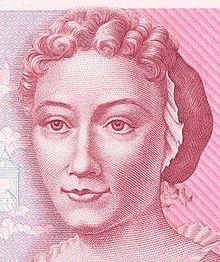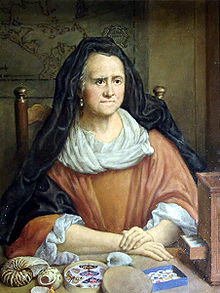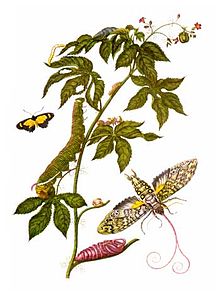- Maria Sibylla Merian
-
Maria Sibylla Merian 
Born 2 April 1647
Frankfurt, GermanyDied 3 January 1717 (aged 69)
Amsterdam, NetherlandsOccupation Naturalist, scientific illustrator, entomologist Known for Documentation of butterfly metamorphosis, scientific illustration Maria Sibylla Merian (April 2, 1647 – January 13, 1717) was a naturalist and scientific illustrator who studied plants and insects and made detailed paintings about them. Her detailed observations and documentation of the metamorphosis of the butterfly make her a significant, albeit not well known, contributor to entomology.[1]
Contents
Biography
Maria Sibylla Merian was born on April 2, 1647 in Frankfurt, Germany, into the family of Swiss engraver and publisher Matthäus Merian the Elder. Her father died three years later and in 1651 her mother married still life painter Jacob Marrel. Marrel encouraged Merian to draw and paint. At the age of 13 she painted her first images of insects and plants from specimens she had captured.
- "In my youth, I spent my time investigating insects. At the beginning, I started with silk worms in my home town of Frankfurt. I realised that other caterpillars produced beautiful butterflies or moths, and that silk worms did the same. This led me to collect all the caterpillars I could find in order to see how they changed". (foreword from Metamorphosis insectorum Surinamensium — Metamorphosis of the Insects of Surinam)
In 1665 Merian married Marrell's apprentice, Johann Andreas Graff. Two years later she had her first child, Johanna Helena, and the family moved to Nuremberg. While living there, Maria Sibylla continued painting, working on parchment and linens, and creating designs for embroidery patterns. She took on many students, which helped the family financially, and increased their social standing. This provided her with access to the finest gardens, maintained by the wealthy and elite.
In those gardens, Merian began studying insects, particularly the lifecycle of caterpillars and butterflies. The scholars of the time believed that insects came from "spontaneous generation of rotting mud", an Aristotelian idea held in spite of—or perhaps because of—the teachings of the Catholic Church. Although St Thomas Aquinas concluded that spontaneous generation of insects was the work of the Devil, Pope Innocent V in the thirteenth century had declared that belief in spontaneous generation went against Church teachings, since all life was created in the first days of Creation chronicled in Genesis; however, the Greek tradition prevailed in the scientific community. Against the prevailing opinion, Merian studied what actually happened in the transformation of caterpillars into butterflies. She took note of the transformations, along with the details of the chrysalises and plants that they used to feed themselves, and illustrated all the stages of their development in her sketch book.
This book of sketches turned into her first book, the first edition of which was sold in 1675 at the age of 28 under the title Neues Blumenbuch -- New book of flowers. In 1678 her second daughter, Dorotha Maria (wife of painter Georg Gsell), was born, and one year later she published another book called Der Raupen wunderbare Verwandlung und sonderbare Blumennahrung -- The Caterpillar, Marvelous Transformation and Strange Floral Food. In this book she presented the stages of development of different species of butterflies along with the plants on which they fed.
In 1681 Jacob Marrell died and the Graff family returned to Frankfurt in 1683 to handle the estate, including the house, art work, library and financial issues left unresolved at the time of his death. A lawsuit was filed by the fractured factions of the families. Upon its resolution in 1685, at the age of 38, Merian left her husband. Accompanied by her mother and daughters, she moved to the Labadist religious commune in Friesland,[2] whose practices included celibacy. The family moved into a home owned by Cornelis van Sommelsdijk, the governor of Surinam. Here she studied the world of South American tropical flora and fauna.
Five years later her mother died and she moved to Amsterdam. Merian's husband divorced her two years later, in 1692. In Amsterdam Merian and her work attracted the attention of various contemporary scientists. Her older daughter, Johanna Helena, married merchant Jacob Herolt and moved with him to Surinam, which was at that time a recently acquired Dutch colony.
In 1699 the city of Amsterdam sponsored Merian to travel to Surinam along with her younger daughter, Dorothea Maria. Before departing, she wrote:
- In Holland, I noted with much astonishment what beautiful animals came from the East and West Indies. I was blessed with having been able to look at both the expensive collection of Doctor Nicolaas Witsen, mayor of Amsterdam and director of the East Indies society, and that of Mr. Jonas Witsen, secretary of Amsterdam. Moreover I also saw the collections of Mr. Fredericus Ruysch, doctor of medicine and professor of anatomy and botany, Mr. Livinus Vincent, and many other people. In these collections I had found innumerable other insects, but finally if here their origin and their reproduction is unknown, it begs the question as to how they transform, starting from caterpillars and chrysalises and so on. All this has, at the same time, led me to undertake a long dreamed of journey to Suriname. (foreword in Metamorphosis insectorum Surinamensium)
Merian worked in Surinam (which included what later became known as the French, Dutch and British Guianas) for two years,[2] travelling around the colony and sketching local animals and plants. She also criticized the way Dutch planters treated Amerindian and black slaves. She recorded local native names for the plants and described local uses. In 1701 malaria forced her to return to Netherlands.
 A painting showing the metamorphosis of Thysania agrippina produced in 1705. Another version exists in which all but the opened-winged butterfly is reversed.
A painting showing the metamorphosis of Thysania agrippina produced in 1705. Another version exists in which all but the opened-winged butterfly is reversed.
Back in the Netherlands she sold specimens she had collected and published a collection of engravings about the life in Surinam. In 1705 she published a book Metamorphosis Insectorum Surinamensium about the insects of Surinam.[1] She used Linnaeus'classification of natural species.[2]
In 1715 Merian suffered a stroke and was partially paralysed. She continued her work but the disease probably affected her ability to work; a later registry lists her as a pauper.
Maria Sibylla Merian died in Amsterdam on January 13, 1717. Her daughter Dorothea published Erucarum Ortus Alimentum et Paradoxa Metamorphosis, a collection of her mother's work, posthumously.[citation needed]
In the last years of the 20th century, the work of Merian has been rediscovered and recognised. For example, her portrait was printed on the 500 DM note before Germany converted to the euro. Her portrait has also appeared on a 0.40 DM stamp, released on September 17, 1987, and many schools are named after her. In 2005, a modern research vessel named Maria S. Merian was launched at Warnemünde, Germany.
Her work
Merian worked as a botanic artist. She published three collections of engravings of plants in 1675, 1677 and 1680. Afterwards she studied insects, keeping her own live specimens, and made drawings showing insect metamorphosis, in which all life stages of the insect (egg, larva, pupa, and adult) were depicted in the same drawing. In her time, it was very unusual that someone would be genuinely interested in insects, which had a bad reputation and were colloquially called "beasts of the devil." As a consequence of their reputation, the metamorphosis of these animals was largely unknown. Merian described the life cycles of 186 insect species, amassing evidence that contradicted the contemporary notion that insects were "born of mud" by spontaneous generation.
Moreover, although certain scholars were aware of the process of metamorphosis from the caterpillar to the butterfly, the majority of people did not understand the process.
The work that Anna Maria Sibylla Merian published, Der Raupen wunderbare Verwandlung und sonderbare Blumennahrung -- The Caterpillars' Marvelous Transformation and Strange Floral Food, was very popular in certain sections of high society as a result of being published in the vernacular. However, it is notable that her work was largely ignored by scientists of the time because the official language of science was still Latin.
Merian also described many other details of the evolution and lifecycle of the insects she observed. She could, for example, show that each stage of the change from caterpillar to butterfly depended on a small number of plants for its nourishment. As a consequence the eggs were laid near these plants.
Her work places her among one of the first naturalists to have observed insects directly. This approach gave her much more insight into their lives and was contrary to the way that most scientists worked at the time.
The pursuit of her work in Suriname was an unusual endeavour, especially for a woman. In general, men received royal or government funding to travel in the colonies to find new species of plants and animals, make collections and to work there, or to settle. Scientific expeditions at this period of time were not common, and Merian's unofficial, self-funded expedition raised many eyebrows. She succeeded, however, in discovering a whole range of previously unknown animals and plants in the interior of Surinam. Merian spent time studying and classifying her findings and described them in great detail. Her classification of butterflies and moths is still relevant today. She used Native American names to refer to the plants, which became used in Europe:
- "I created the first classification for all the insects which had chrysalises, the daytime butterflies and the nighttime moths. The second classification is that of the maggots, worms, flies and bees. I retained the indigenous names of the plants, because they were still in use in America by both the locals and the Indians". (in the foreword of Metamorphosis insectorum Surinamensium).
Her drawings of plants, frogs,[3] snakes, spiders, iguanas and tropical beetles are still collected today by amateurs all over the world. The German word Vogelspinne—mygalomorphae, translated literally as bird spider—probably has its origins in an engraving by Maria Sibylla Merian. The engraving, created from sketches drawn in Surinam, shows a large spider who had just captured a bird. In the same engraving and accompanying text Merian was the first European to describe both army ants and leaf cutter ants and their effect on other organisms[4] .See also
- Women artists
- RV Maria S. Merian is Germany's most modern research vessel, named after Merian.
Bibliography
- Neues Blumenbuch. Volume 1. 1675
- Neues Blumenbuch. Volume 2. 1677
- Neues Blumenbuch. Volume 3. 1677
- Der Raupen wunderbare Verwandlung und sonderbare Blumennahrung. 1679
- Metamorphosis insectorum Surinamensium. 1705
Footnotes
- ^ a b Kristensen, Niels P. (1999). "Historical Introduction". In Kristensen, Niels P.. Lepidoptera, moths and butterflies: Evolution, Systematics and Biogeography. Volume 4, Part 35 of Handbuch der Zoologie:Eine Naturgeschichte der Stämme des Tierreiches. Arthropoda: Insecta. Walter de Gruyter. p. 1. ISBN 9783110157048. http://books.google.co.in/books?id=B9rdQ1gHuAAC. Retrieved 30 November 2010.
- ^ a b c de Bray (2001), p. 48.
- ^ Etheridge, Kay (2010). Bibliotheca Herpetologica 8: 20–27. http://public.gettysburg.edu/~ketherid/merianfrogs.pdf.
- ^ Etheridge, Kay (2011). "Maria Sibylla Merian and the metamorphosis of natural history". Endeavour 35: 16–22. http://public.gettysburg.edu/~ketherid/Endeavor.pdf.
References
- de Bray, Lys (2001). The Art of Botanical Illustration: A history of classic illustrators and their achievements. Quantum Publishing Ltd., London. ISBN 1-86160-425-4.
- Patricia Kleps-Hok: Search for Sibylla: The 17th Century's Woman of Today, U.S.A 2007, ISBN 1-4257-4311-0; ISBN 1-4257-4312-9.
- Helmut Kaiser: Maria Sibylla Merian: Eine Biografie. Artemis & Winkler, Düsseldorf 2001, ISBN 3-538-07051-2
- Uta Keppler: Die Falterfrau: Maria Sibylla Merian. Biographischer Roman. dtv, München 1999, ISBN 3-423-20256-4 (Nachdruck der Ausgabe Salzer 1977)
- Charlotte Kerner: Seidenraupe, Dschungelblüte: Die Lebensgeschichte der Maria Sibylla Merian. 2. Auflage. Beltz & Gelberg, Weinheim 1998, ISBN 3-407-78778-2
- Dieter Kühn: Frau Merian! Eine Lebensgeschichte. S. Fischer, Frankfurt 2002, ISBN 3-10-041507-8
- Inez van Dullemen: Die Blumenkönigin: Ein Maria Sybilla Merian Roman. Aufbau Taschenbuch Verlag, Berlin 2002, ISBN 3-7466-1913-0
- Kurt Wettengl: Von der Naturgeschichte zur Naturwissenschaft - Maria Sibylla Merian und die Frankfurter Naturalienkabinette des 18. Jahrhunderts. Kleine Senckenberg-Reihe 46: 79 S., Frankfurt am Main 2003
- Kim Todd: Chrysalis: Maria Sibylla Merian and the Secrets of Metamorphosis. Harcourt, USA, 2007. ISBN 0-1510-11087.
- Ella Reitsma: "Maria Sibylla Merian & Daughters, Women of Art and Science" Waanders, 2008. ISBN 978-90-400-8459-1.
Further reading
- Davis, Natalie Zemon. Women on the Margins: Three Seventeenth-Century Lives. Cambridge: Harvard UP, 1995, pp. 140-202.
- Reidell, Heidi. "A Study of Metamorphosis." Américas Magazine. March–April 2008, pp. 28–35.
External links
- Metamorphosis Insectorum Surinamensium:
- Metamorphosis insectorum Surinamensium images
- Online version of Metamorphosis insectorum Surinamensium from GDZ
- Metamorphosis Insectorum Surinamensium (1705) - digital facsimile, Linda Hall Library
- Other
- German Language Site on Maria with Music and a lot of images
- Online version of Over de voortteeling en wonderbaerlyke veranderingen der Surinaemsche Insecten from GDZ
- Online version of Erucarum ortus, alimentum et paradoxa metamorphosis from GDZ
- Online version of De Europische Insecten
- The Flowering Genius of Maria Sibylla Merian Ingrid Rowland on Merian from The New York Review of Books
- Der Raupen wunderbare Verwandlung ...images
 "Merian, Marie Sibylle". Appletons' Cyclopædia of American Biography. 1900.
"Merian, Marie Sibylle". Appletons' Cyclopædia of American Biography. 1900.
Categories:- 1647 births
- 1717 deaths
- People from Frankfurt
- Swiss botanists
- Swiss illustrators
- Botanical illustrators
- Swiss entomologists
- Scientific illustrators
- 17th-century Swiss people
- German Baroque painters
- German women artists
- Dutch Golden Age painters
- Women painters
- Swiss women artists
Wikimedia Foundation. 2010.



